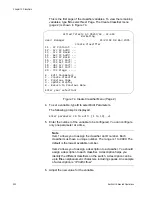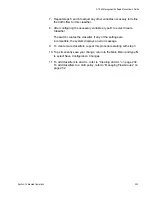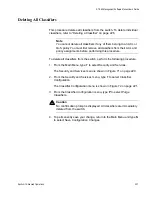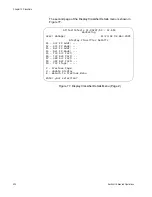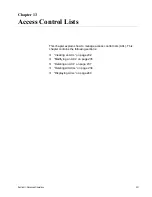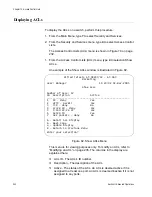
Chapter 13: Access Control Lists
236
Section II: Advanced Operations
5. To change the description of the ACL, type
2
to select Description and
enter a new description for the ACL. The description can be up to 31
alphanumeric characters. Spaces are allowed. This parameter is
optional, though recommended. Assigning each ACL a name will
make it easier for you to identify them.
6. To change the ACL’s action, type
3
to select Action.
The following prompt is displayed:
Enter Value [0-Deny, 1-Permit] : [0 to 1] -> 0
7. Type
0
if you want the ACL to discard ingress packets that meet the
criteria in the classifiers to be assigned to the ACL or
1
if the packets
are to be accepted. The default setting is Deny.
8. To change the classifiers assigned to the ACL, type
4
to select
Classifier List and, when prompted, enter the classifiers. The prompt
includes the ID numbers of the classifiers on the switch. You can
assign more than one classifier to an ACL. Separate multiple
classifiers with a comma (for example, 2,4,7). The order in which you
specify the classifiers is not important.
When entering classifiers, keep in mind the action you specified for
this ACL in step 7. The action and the traffic flows defined by the
classifiers should correspond. For instance, an ACL with an action of
permit should be assigned those classifiers that define the traffic flow
you want ports to accept.
9. To change the ports to which the ACL is assigned, type
5
to select Port
List and, when prompted, enter the ports where you want to assign the
ACL. You can assign an ACL to more than one port. Ports can be
listed individually (e.g., 2,5,7), as a range (e.g., 8-12) or both (e.g., 1-
4,6,8).
10. Type
M
to select Modify ACL.
The ACL is modified on the switch. Modifications take affect
immediately.
11. To modify additional ACLs, repeat this procedure starting with step 3.
12. To permanently save your change, return to the Main Menu and type
S
to select Save Configuration Changes.
Summary of Contents for AT-9400
Page 16: ...Figures 16 ...
Page 18: ...Tables 18 ...
Page 28: ...Preface 28 ...
Page 30: ...30 Section I Basic Operations ...
Page 60: ...Chapter 1 Basic Switch Parameters 60 Section I Basic Operations ...
Page 64: ...Chapter 2 Port Parameters 64 Section I Basic Operations Port Type The port type ...
Page 84: ...Chapter 2 Port Parameters 84 Section I Basic Operations ...
Page 124: ...Chapter 6 Static Port Trunks 124 Section I Basic Operations ...
Page 144: ...144 Section II Advanced Operations ...
Page 196: ...Chapter 10 File Downloads and Uploads 196 Section II Advanced Operations ...
Page 218: ...Chapter 11 Event Logs and the Syslog Client 218 Section II Advanced Operations ...
Page 242: ...Chapter 13 Access Control Lists 242 Section II Advanced Operations ...
Page 294: ...294 Section III IGMP Snooping MLD Snooping and RRP Snooping ...
Page 314: ...Chapter 19 MLD Snooping 314 Section III IGMP Snooping MLD Snooping and RRP Snooping ...
Page 318: ...318 Section IV SNMPv3 ...
Page 416: ...Chapter 21 SNMPv3 416 Section IV SNMPv3 ...
Page 418: ...418 Section V Spanning Tree Protocols ...
Page 470: ...470 Section VI Virtual LANs ...
Page 520: ...Chapter 26 Multiple VLAN Modes 520 Section VI Virtual LANs ...
Page 532: ...Chapter 27 Protected Ports VLANs 532 Section VI Virtual LANs ...
Page 546: ...546 Section VII Internet Protocol Routing ...
Page 560: ...560 Section VIII Port Security ...
Page 568: ...Chapter 30 MAC Address based Port Security 568 Section VIII Port Security ...
Page 586: ...Chapter 31 802 1x Port based Network Access Control 586 Section VIII Port Security ...
Page 588: ...588 Section IX Management Security ...
Page 610: ...Chapter 33 Encryption Keys 610 Section IX Management Security ...
Page 650: ...Chapter 36 TACACS and RADIUS Protocols 650 Section IX Management Security ...
Page 660: ...Chapter 37 Management Access Control List 660 Section IX Management Security ...
Page 668: ...Index 668 ...

